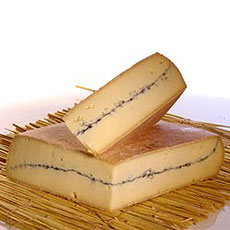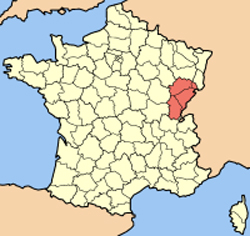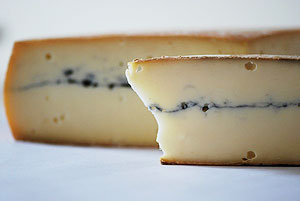

Morbier is a semisoft, Gruyère-like cheese with a striking vein of ash through the middle. Photo courtesy Murray’s Cheese.
March 2009
|
 |
Morbier Cheese
The “Child” Of Gruyère
CAPSULE REPORT: Morbier (more-bee-YAY) is one of France’s best-known cheeses. It is a semi-soft, aromatic and surprisingly mild French cow’s milk cheese, defined by the dark vein of vegetable ash streaking through its middle. This is Page 1 of a two-page article. Click on the black links below to visit Page 2.
Overview
Like Gruyère? Then you’re sure to like Morbier. Morbier was first produced more than 250 years ago in the small village of Morbier in Franche-Comté, a province in eastern central France, bordering Switzerland. It’s a semisoft raw cow’s milk cheese similar to Gruyère, but it has a signature stripe of ash through the middle. The two layers of the cheese originally came from two milkings, one in the morning and one in the evening, but these days it’s usually composed of just one milking, and made into 12-pound wheels, as opposed to the much larger, 70-pound wheels of Gruyère. The Morbiers of Jura and Doubs, départments (like counties) within the province, are designated Appellation d’Origine Contrôlée (AOC), although non-AOC Morbiers are made in the other two départments.
About Morbier Cheese
One might call Morbier the “child” of Gruyère, the better-known cheese that has been made since the reign of Charlemagne (768-814 C.E.), in what is today the  Franche-Comté region of France. Local cheesemakers who made Gruyère de Comté often had leftover curds at the end of the day—not enough to make a full Gruyère. They would press the leftover curd from the evening production into a mold and cover it with a protective thin layer of tasteless ash, both to prevent it from both drying out and to keep away the flies. The next day, they would add the leftover curd from the morning milking and production. The result was a two-layered cheese. With today’s modern production techniques, the ash is purely decorative but a defining characteristic of the cheese that lets one identify it from 10 paces. Franche-Comté region of France. Local cheesemakers who made Gruyère de Comté often had leftover curds at the end of the day—not enough to make a full Gruyère. They would press the leftover curd from the evening production into a mold and cover it with a protective thin layer of tasteless ash, both to prevent it from both drying out and to keep away the flies. The next day, they would add the leftover curd from the morning milking and production. The result was a two-layered cheese. With today’s modern production techniques, the ash is purely decorative but a defining characteristic of the cheese that lets one identify it from 10 paces.
Map of the Franche-Comté region of France courtesy of Wikipedia Commons.
Morbier is aged for at least 60 days and up to four months, creating a tan rind and an ivory paste. It has an assertive aroma, but a mild. Morbier is known for its complex fruity flavor and slight tang. The two layers of the cheese have slightly different flavors; the layer from the evening milking tastes fruitier than the one from the morning milking.
Mobay Is Not Morbier
Do not confuse Morbier with the American Mobay cheese, a Wisconsin semisoft cheese made of one layer of goat’s milk and one of sheep’s milk. In appearance it is similar to Morbier, with ash separating the two layers. While Mobay is a lovely cheese, the taste has nothing in common with Morbier, since the milk used is not the same.
Food & Wine Pairings
You can enjoy Morbier:
 With French saucisson With French saucisson- On a sandwiches made with
crusty bread
- With salads, fruit, tomatoes and smoked meats
- As a melting cheese for fondue, cheese sauces, grilled cheese and and cheese melts
- As a table cheese (take it out of the refrigerator at least half an hour before eating, and be sure to eat Morbier before stronger cheeses)
Morbier cheese has a striking layer of ash through its center. Photo courtesy ArtisanalCheese.com.
- Pair Morbier with Pinot Noir or Gewürtztraminer; with Chardonnay; or with wines from its home region, the Jura, such as Savagnin and red and white wines from Arbois.
Continue To Page 2: How Morbier Cheese Is Made
Go To The Article Index Above
Lifestyle Direct, Inc. All rights reserved. Images are the copyright of their respective owners.

|



 Franche-Comté region of France. Local cheesemakers who made Gruyère de Comté often had leftover curds at the end of the day—not enough to make a full Gruyère. They would press the leftover curd from the evening production into a mold and cover it with a protective thin layer of tasteless ash, both to prevent it from both drying out and to keep away the flies. The next day, they would add the leftover curd from the morning milking and production. The result was a two-layered cheese. With today’s modern production techniques, the ash is purely decorative but a defining characteristic of the cheese that lets one identify it from 10 paces.
Franche-Comté region of France. Local cheesemakers who made Gruyère de Comté often had leftover curds at the end of the day—not enough to make a full Gruyère. They would press the leftover curd from the evening production into a mold and cover it with a protective thin layer of tasteless ash, both to prevent it from both drying out and to keep away the flies. The next day, they would add the leftover curd from the morning milking and production. The result was a two-layered cheese. With today’s modern production techniques, the ash is purely decorative but a defining characteristic of the cheese that lets one identify it from 10 paces.  With French
With French